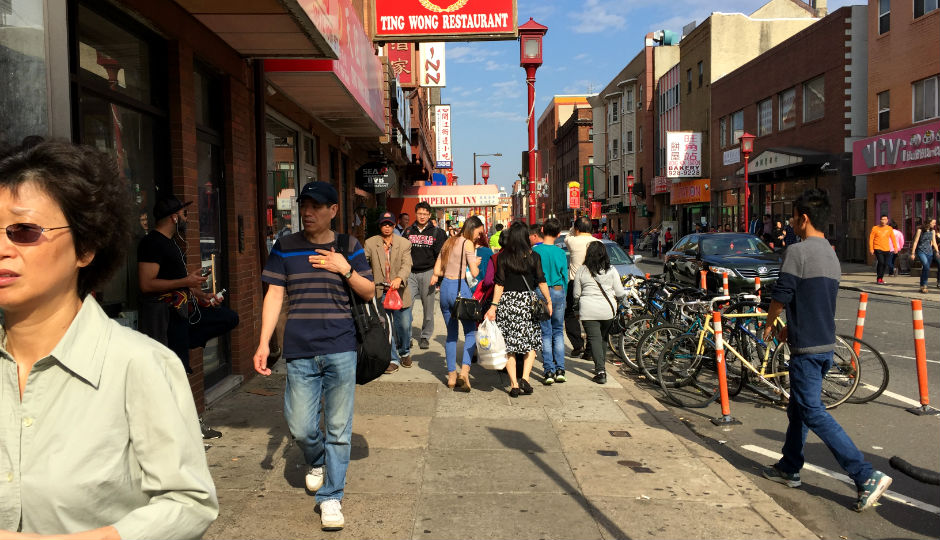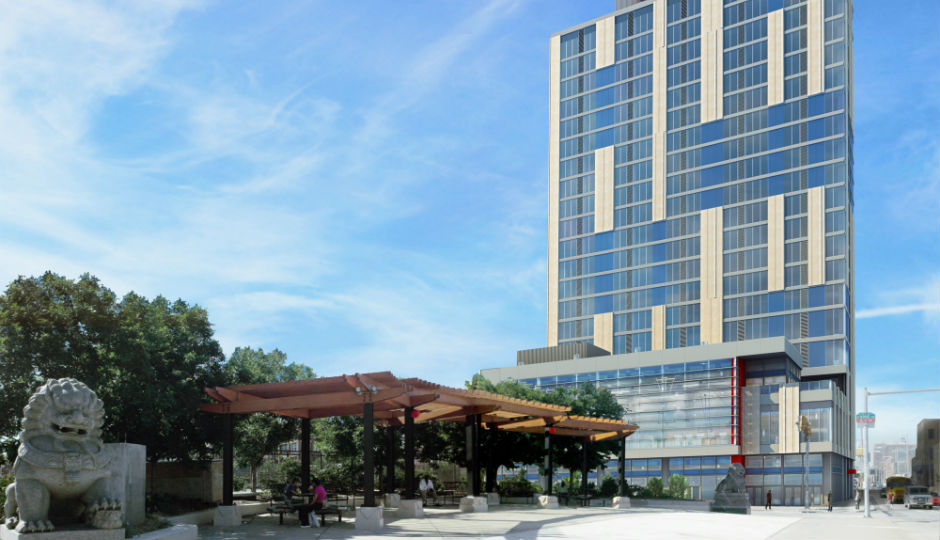As Rail Park Rises, Chinatown Tries to Stay Chinatown

North 10th Street, Chinatown | Photo by Jared Brey
Construction is finally underway on Philadelphia’s much anticipated Rail Park, which will convert the abandoned Reading Viaduct into an elevated greenway. It’s a culmination of sorts, as it took nearly a decade of advocacy and fundraising before the project could get off the ground.
The park itself, raised above street level and cutting diagonally across a broad sweep of northern Center City, is set to become a crown jewel in Philadelphia’s already excellent park system. But the real intrigue is on the ground, where developers, real estate agents, and neighborhood groups have been grappling for years over the identity of the surrounding neighborhood — even over its very name.
As it happens, funds from the same state program that made the first phase of the Rail Park possible were recently granted to the Philadelphia Chinatown Development Corporation to start work on the Eastern Tower, a combined apartment complex and community center that’s been in the works for about as long as the Viaduct project. If all goes according to plan, the tower will start to rise later this year on the north side of Vine Street at 10th. In addition to providing community space in a neighborhood that has none, it will also mark a strong claim that the neighborhood — at least this part of it — is still Chinatown.
“I think in terms of housing, you really have an opportunity there to create a community that’s invested in the neighborhood,” said Sarah Yeung, director of planning at PCDC, in her office last week. “You can have folks that are coming in from New York and D.C. just looking for a cheap place to crash, or you can have folks who are really interested in the community and want to be engaged in local matters, and maybe have a tie to the culture and a family and network here.”

Eastern Tower | Studio Agoos Lovera
CHINATOWN IS BOXED IN on all four sides by oversized, inorganic things. To the east is an empty parking lot bounded by 8th, 9th, Race, and Vine that’s owned by the Redevelopment Authority. To the south is the Greyhound Bus terminal and the blank concrete wall of the Gallery at Market East. To the west is the Pennsylvania Convention Center, which looks sad and plastic, the way wearing a nametag feels. North is the Vine Street Expressway.
For a long time, the territory on the far side of the expressway, up to Spring Garden, was a poor area studded with hulking warehouses and closed factories. But lately, as Center City has grown, developers have filled in vacant lots and retrofitted old industrial spaces for offices and apartments. Callowhill and Chinatown North are two of the more established names for parts of the area, and the ones the city has officially recognized in planning documents. Various people have taken to calling the area, or certain subsections of it, the Loft District, Spring Arts, and the Eraserhood.
The pressure to define the neighborhood to the north, and to cash in on its rising property values, is only going to increase as the Reading Viaduct is transformed.
“[The Rail Park] is not just a park,” Yeung said. “It’s an economic development project, and it’s seen as a regional benefit. It has not been discussed in terms of its local impact or its local benefit and value, and I think that’s a really dangerous situation that is rife with potential for inequity.”
One of the remarkable things about Chinatown proper is that it’s basically one block after another of the exact mix of things that professional city planners and amateur city lovers like to see in a streetscape. It’s a uniquely urban environment, densely built and full of life, and more compact even than other parts of Center City that have taller buildings. Its sidewalks are lined with restaurants, delis, pharmacies, grocery stores, and other storefronts, the kinds of places where neighbors are at home and strangers are welcome. The commercial corridors that draw people to East Passyunk and Germantown and Northern Liberties and Spruce Hill — Chinatown is that, front to back.
It has endured this way for many decades. Over the years it has lost battles, like when parts of its northern boundary were chopped off so the Vine Street Expressway could tunnel across the city, and it has won some, like when it shut down a proposed baseball stadium and, later, a casino. (There’s some good neighborhood history here.)
The Chinatown Development Corporation has spent the last 50 years working to maintain the neighborhood as an accessible gateway for low-income Asian immigrants. Most recently, PCDC worked with Project HOME to build 94 units of affordable housing at 8th and Arch. Yeung said that there’s now a growing demand for market-rate housing, from immigrants and others. That’s a sign that the community is thriving, but it also makes it harder to develop housing for low-income people. PCDC has even started to look elsewhere, recently embarking on a project to build scattered-site affordable housing north of Spring Garden Street.
The name “Chinatown North” started to catch on around the time that Asian Arts Initiative moved to the north side of Vine, after being booted from its former home so the Convention Center could be built. Along with institutions like the Holy Redeemer Chinese Catholic Church and School and the Hing Wah Yuen housing development, the Eastern Tower, which is almost entirely market-rate, will stabilize Chinatown’s northern flank across the expressway.

Eastern Tower Gym | Studio Agoos Lovera
EASTERN TOWER STARTED OUT as a small-scale plan to build a community recreation center in Chinatown, which has no such amenities to call its own. But PCDC quickly learned that it would be close to impossible to construct and operate a standalone community center, Yeung told me, so the project evolved to include market-rate apartments to subsidize the community space, as well as 21,000 square feet of offices and commercial storefronts at the street level.
And it’s taken a smorgasbord of financing mechanisms to raise the $75 million needed to start the project, said Ahsan Nasratullah, president of JNA Capital, which is partnering with PCDC on the project. That includes two grants from the state and $11 million in New Markets Tax Credits, a federal program that encourages development in underdeveloped areas. Nasratullah also started the Global City Regional Center in order to raise funds through the EB-5 tax program, which allows foreign investors to get expedited green cards if they put $500,000 or more into certain types of community development or infrastructure projects. Add to that some private equity, traditional bank loans and a $15,000 check from some Chinatown kids, and the project is almost ready for groundbreaking.
Over the summer, Yeung used a grant from the Knight Foundation to carry out a project that involved inviting people to spend time on the 10th Street overpass above the Vine Street Expressway. The spot is already lightly built out as a sort of plaza, though people don’t often congregate there. Yeung put on music, hosted performances and laid out a drum set and a bunch of games like mahjong and Chinese chess. It was pretty successful, she told me. Senior citizens in particular came out and played mahjong for hours at a time.
The streets and sidewalks are currently the only community spaces in Chinatown. The Eastern Tower will give residents their first recreation center, with space for the Philadelphia Suns, a youth basketball and lion-dancing group. Yeung hopes it gets people to cross the expressway more often, and goes a small way toward mending that open wound.
But the project is more than just housing and community space. It’s not hard to imagine the neighborhood north of the expressway taking on a new name in a few years — Viaductland, maybe, or Rail Park Place. As much as any neighborhood in Philly, Chinatown has had to fight for its right to exist. Refusing to allow the expressway to be its permanent boundary is a credit to its perseverance.
“I think people forget that Chinatown was founded out of racial discrimination and fear of racial violence,” Yeung said. “The immigrant experience is certainly one that’s very different from, say, the black experience in America. But at the same time, the reason why there is a Chinatown is similar to the reason why there are poor black neighborhoods today—out of redlining, because they were forced to be in these neighborhoods together. And the fact that these historic gateways have become thriving neighborhoods makes it all the more heartbreaking to see some of these neighborhoods be displaced and dissipated because of hot markets that are breaking up the ability for these communities to continue to exist.”
Follow @jaredbrey on Twitter.